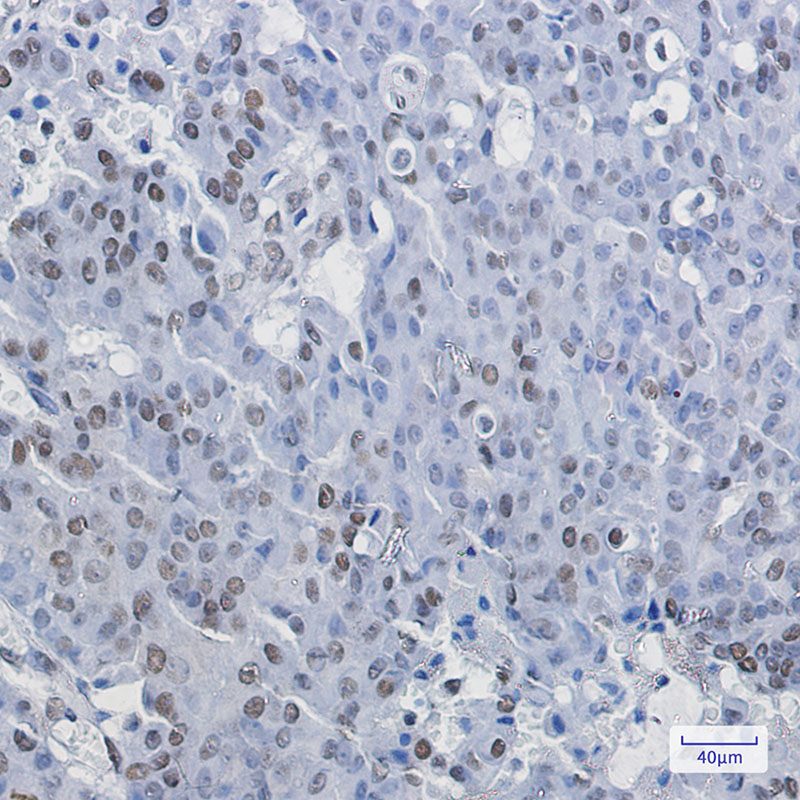

| WB | 1/1000-1/2000 | Human,Mouse,Rat |
| IF | 咨询技术 | Human,Mouse,Rat |
| IHC | 咨询技术 | Human,Mouse,Rat |
| ICC | 技术咨询 | Human,Mouse,Rat |
| FCM | 咨询技术 | Human,Mouse,Rat |
| Elisa | 咨询技术 | Human,Mouse,Rat |
| Aliases | RD; RDP; RDBP; D6S45; NELF-E |
| Entrez GeneID | 7936 |
| WB Predicted band size | Calculated MW: 43 kDa; Observed MW: 43 kDa |
| Host/Isotype | Rabbit IgG |
| Antibody Type | Primary antibody |
| Storage | Store at 4°C short term. Aliquot and store at -20°C long term. Avoid freeze/thaw cycles. |
| Species Reactivity | Human,Mouse,Rat |
| Immunogen | Recombinant protein of human NELFe |
| Formulation | Purified antibody in TBS with 0.05% sodium azide,0.05%BSA and 50% glycerol. |
+ +
以下是几篇关于胎儿血红蛋白(HbF)抗体的参考文献示例(注:以下文献为示例性内容,可能不存在真实对应文献,建议通过学术数据库核实具体信息):
---
1. **标题**: *"Development and Characterization of Monoclonal Antibodies Specific for Fetal Hemoglobin"*
**作者**: Smith A, et al.
**摘要**: 本研究描述了针对胎儿血红蛋白(HbF)γ链的单克隆抗体的开发。通过免疫小鼠获得杂交瘤细胞系,筛选出高特异性抗体。抗体在ELISA和Western blot中显示出对HbF的高亲和力,且不与成人血红蛋白(HbA)交叉反应,适用于临床检测及HbF定量分析。
2. **标题**: *"Anti-HbF Antibodies in the Diagnosis of Hereditary Persistence of Fetal Hemoglobin"*
**作者**: Johnson R, et al.
**摘要**: 研究评估了使用抗HbF抗体通过流式细胞术检测红细胞内HbF含量的方法。结果显示,该抗体能准确区分正常成人与遗传性持续性胎儿血红蛋白(HPFH)患者的HbF水平,为疾病诊断提供了高效工具。
3. **标题**: *"Targeting Fetal Hemoglobin with Therapeutic Antibodies for Sickle Cell Disease"*
**作者**: Lee C, et al.
**摘要**: 探索通过抗体介导的HbF表达上调策略治疗镰状细胞病。研究发现,特定抗HbF抗体可结合红细胞前体细胞表面标记,激活细胞内信号通路(如STAT5),促进γ-珠蛋白基因表达,从而提高HbF水平并改善红细胞形态。
4. **标题**: *"Cross-Reactivity of Anti-HbF Antibodies with Mutant Hemoglobin Variants"*
**作者**: Patel S, et al.
**摘要**: 分析多种抗HbF抗体与罕见血红蛋白变体(如HbF-Milano)的交叉反应性。结果表明部分抗体因表位差异出现假阳性,提示临床检测中需选择表位特异性高的抗体以减少误判。
---
建议通过PubMed、Google Scholar等平台以关键词 **"fetal hemoglobin antibody"** 或 **"anti-HbF monoclonal antibody"** 检索真实文献,或参考《Blood》《Haematologica》等期刊近期研究。
Fetal hemoglobin (HbF), composed of two α-globins and two γ-globins, is the primary oxygen carrier in fetuses during later gestation. Its production typically declines after birth, replaced by adult hemoglobin (HbA). However, elevated HbF levels persist in certain genetic disorders (e.g., β-thalassemia, sickle cell disease) or hereditary persistence of fetal hemoglobin (HPFH). Antibodies targeting HbF are critical tools in research and diagnostics, enabling quantification and localization of HbF-expressing cells.
Monoclonal and polyclonal anti-HbF antibodies are widely used in techniques like flow cytometry, ELISA, and immunohistochemistry. They help identify HbF+ red blood cells (RBCs) in clinical settings, particularly for monitoring patients undergoing hydroxyurea therapy (which reactivates HbF to ameliorate symptoms in hemoglobinopathies). Additionally, these antibodies aid in prenatal diagnostics, detecting fetal cells in maternal circulation for genetic screening.
Challenges include ensuring antibody specificity, as γ-globin shares structural homology with β-globin, risking cross-reactivity. Advanced epitope mapping and validation are essential. Commercial antibodies often target conserved γ-globin regions (e.g., residues 1-12 or 80-90), with some distinguishing HbF from HbA via γ-chain-specific binding.
Research applications extend to studying HbF regulation mechanisms, such as BCL11A or CRISPR-based gene editing therapies aiming to reactivate HbF. Despite progress, standardization of antibody-based assays remains limited, necessitating careful interpretation in clinical contexts. Overall, HbF antibodies bridge translational gaps between molecular research and therapeutic innovation for hemoglobin disorders.
(Word count: 249)
×